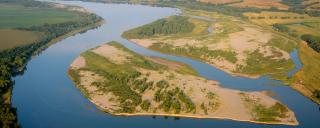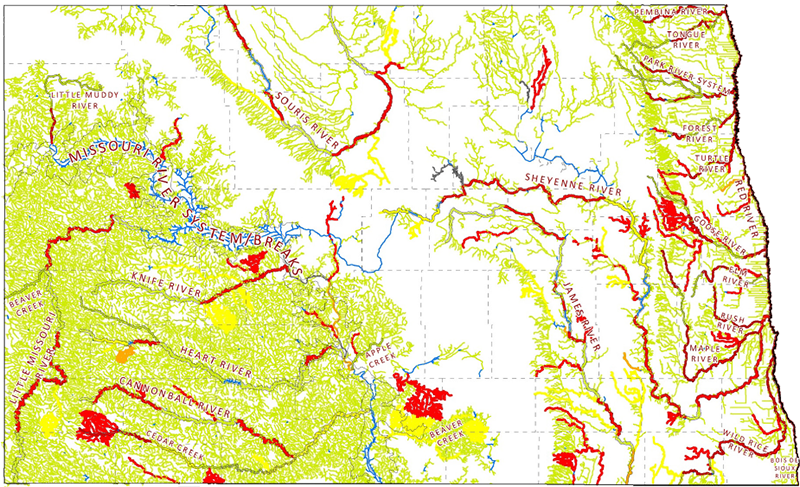
Rivers, Streams and Riparian
Area: 56,022 miles of rivers and streams
Description and Overall Condition: This landscape component includes all rivers, streams, and associated riparian areas which are distributed throughout the state. River floodplains and the associated riparian habitat represent narrow corridors of unique habitat in the state. Overuse of cattle grazing in some areas causes degradation to riparian habitat and is one factor relating to reduced water quality (i.e. fecal coliform bacteria and Escherichia coli impairment).
Development such as increased housing along the Missouri River is disturbing to some wildlife species and destroys riparian habitat. Many small low-head dams have impeded fish movement. The creation of larger dams such as Garrison Dam resulted in numerous positive benefits, but is an obstruction in the natural cycle of cottonwood regeneration and fish movement. The North Dakota 2014 Integrated Water Quality Report (NDDOH 2015) reported 47% of rivers and streams as fully supporting but threatened for aquatic life use, 28% are fully supporting the aquatic life, and 25% were assessed as not supporting aquatic life use. Non-point source pollution, or siltation/sedimentation and stream habitat loss, is a primary cause of aquatic life use impairment. Dissolved oxygen levels are depleted from organic enrichment and nuisance algae and plant growth is a result of excessive nutrient loading.
Predominant Natural Vegetation
Trees and Shrubs
cottonwood, American elm, green ash, box elder, bur oak, basswood, hackberry, peachleaf willow, hophornbeam, prickly ash, Missouri gooseberry, black currant, buckthorn, nannyberry
Forbs Virginia wild rye, nodding muhly, charming sedge, Sprengel's sedge, jack-in-the-pulpit, wood leek, large bellwort, false Solomon's seal, Solomon's seal, nodding trillium, carrion flower, tall nettle, wood nettle, wild four-o-clock, baneberry, wild ginger, columbine, kidneyleaf buttercup, tall meadowrue, bloodroot, yellow wood violet, pink wood violet, white avens, sweet cicely, wild sarsaparilla, honeywort, waterleaf, yellow wood parsnip, fringed loostrife, tall coneflower
Associated Species of Conservation Priority
Birds
golden eagle, bald eagle, red-headed woodpecker, black-billed cuckoo, whooping crane, piping plover, red knot, least tern
Mammals
northern long-eared bat, western small-footed bat, long-legged bat, long-eared bat, big brown bat, little brown bat, pygmy shrew, river otter
Reptiles/Amphibians
false map turtle, smooth softshell, spiny softshell, snapping turtle
Fish
chestnut lamprey, silver lamprey, pallid sturgeon, paddlefish, sturgeon chub, sicklefin chub, silver chub, northern pearl dace, hornyhead chub, pugnose shiner, blacknose shiner, carmine shiner, northern redbelly dace, finescale dace, flathead chub, blue sucker, yellow bullhead, trout-perch, logperch, river darter, largescale stoneroller, burbot
Mussels
threeridge, wabash pigtoe, mapleleaf, black sandshell, creek heelsplitter, pink heelsplitter, pink papershell, fragile papershell, deertoe, creeper
Other Characteristic Wildlife
Birds
wood duck, mallard, hooded merganser, common merganser, turkey vulture, osprey, sharp-shinned hawk, Cooper's hawk, red-tailed hawk, American kestrel, ring-necked pheasant, wild turkey, American woodcock, mourning dove, yellow-billed cuckoo, great horned owl, Eastern screech owl, barred owl, long-eared owl, common nighthawk, chimney swift, ruby-throated hummingbird, yellow-bellied sapsucker, downy woodpecker, hairy woodpecker, yellow-shafted flicker, pileated woodpecker, Western wood pewee, Eastern wood-pewee, yellow-bellied flycatcher, willow flycatcher, least flycatcher, Eastern flycatcher, great crested flycatcher, purple martin, tree swallow, Northern rough-winged swallow, bank swallow, cliff swallow, blue jay, black- billed magpie, common crow, black-capped chickadee, white-breasted nuthatch, brown creeper, house wren, Eastern bluebird, veery, wood thrush, American robin, gray catbird, brown thrasher, cedar waxwing, Bell's vireo, yellow-throated vireo, warbling vireo, Philadelphia vireo, red-eyed vireo, yellow warbler, yellow-rumped warbler, American redstart, ovenbird, Northern waterthrush, common yellowthroat, migratory warblers, scarlet tanager, rose-breasted grosbeak, black-headed grosbeak, lazuli bunting, indigo bunting, spotted towhee, Eastern towhee, chipping sparrow, lark sparrow, clay-colored sparrow, song sparrow, common grackle, brown-headed cowbird, orchard oriole, Bullock's oriole, Baltimore oriole, American goldfinch
Mammals
little brown bat, silver-haired bat, big brown bat, Eastern red bat, hoary bat, Eastern cottontail, woodchuck, Eastern chipmunk, gray squirrel, fox squirrel, Northern flying squirrel, beaver, white-footed mouse, Southern red-backed vole, meadow vole, meadow jumping mouse, Western jumping mouse, porcupine, coyote, red fox, gray fox, raccoon, American marten, ermine, long-tailed weasel, least weasel, bobcat, elk, mule deer, white-tailed deer
Reptiles/Amphibians
Woodhouse's toad, Great Plains toad, gray tree frog, Northern leopard frog, tiger salamander, common mudpuppy, common garter snake, plains garter snake, painted turtle
For more detailed information about this topic, please see the North Dakota Wildlife Action Plan.

